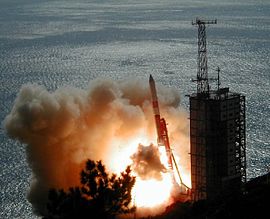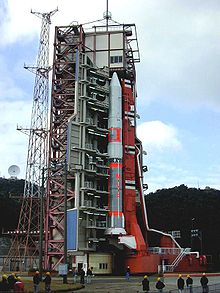- M-V
-
M-V 
The third M-V launches with the ASTRO-E spacecraft.Function All-solid small orbital launch vehicle Manufacturer Nissan Motors (-2000)
IHI AEROSPACE (-2006)[1]Country of origin Japan Size Height 30.8 m (101 ft) Diameter 2.5 m (8.2 ft) Mass 137,500 - 139,000 kg (303,100 - 306,000 lb) Stages 3 or 4 Capacity Payload to LEO 1,800 kg (3,900 lb) Payload to
Polar LEO1,300 kg (2,800 lb) Launch history Status Retired Launch sites Kagoshima Total launches 7 (M-V: 4, M-V KM: 3) Successes 6 (M-V: 3, M-V KM: 3) Failures 1 (M-V) Maiden flight M-V: 10 February 2000
M-V KM: 12 February 1997Last flight M-V: 22 September 2006
M-V KM: 9 May 2003Notable payloads HALCA, Nozomi,
ASTRO-E, Hayabusa
Suzaku, AKARI
HinodeFirst stage - M-14 Engines 1 Solid Thrust 3,780.345 kN (849,855 lbf) Specific impulse 246 sec Burn time 46 seconds Fuel Solid Second stage - M-24 Engines 1 Solid Thrust 1,245.287 kN (279,952 lbf) Specific impulse 203 sec Burn time 71 seconds Fuel Solid Third stage - M-34 Engines 1 Solid Thrust 294 kN (66,093 lbf) Specific impulse 301 sec Burn time 102 seconds Fuel Solid Fourth stage - KM-V1 Engines 1 Solid Thrust 51.9 kN (11,668 lbf) Specific impulse 298 sec Burn time 73 seconds Fuel Solid The M-V rocket, also called M-5 or Mu-5, was a Japanese solid-fuel rocket designed to launch scientific satellites. It was a member of the Mu family of rockets. The Institute of Space and Astronautical Science (ISAS) began developing the M-V in 1990 at a cost of 15 billion yen. It has three stages and is 30.7 meters high, 2.5 meters in diameter, and weighs about 140 tonnes (310,000 pounds). It was capable of launching a satellite weighing 1.8 tonnes (2 short tons) into an orbit as high as 250 km (160 mi).
The first M-V rocket launched the HALCA radio astronomy satellite in 1997, and the second the Nozomi Mars explorer in July 1998. The third rocket attempted to launch the Astro-E X-ray satellite on February 10, 2000 but failed.
ISAS recovered from this setback and launched Hayabusa to 25143 Itokawa in 2003.
The following M-V launch was the scientific Astro-E2 satellite, a replacement for Astro-E, which took place on July 10, 2005.
The final launch was that of the Hinode (SOLAR-B) spacecraft, along with the SSSat microsat and a nanosatellite, HIT-SAT, on 22 September 2006.
Contents
National security considerations
Solid fuel rockets are the design of choice for military applications as they can remain in storage for long periods, and then reliably launch at short notice.
Lawmakers made national security arguments for keeping Japan's solid-fuel rocket technology alive after ISAS was merged into the Japan Aerospace Exploration Agency, which also has the H-IIA liquid-fuelled rocket, in 2003. The ISAS director of external affairs, Yasunori Matogawa, said, "It seems the hard-line national security proponents in parliament are increasing their influence, and they aren't getting much criticism…I think we’re moving into a very dangerous period. When you consider the current environment and the threat from North Korea, it’s scary."[2]
Toshiyuki Shikata, a government adviser and former lieutenant general, indicated that part of the rationale for the fifth M-V Hayabusa mission was that the reentry and landing of its return capsule demonstrated "that Japan's ballistic missile capability is credible."[3]
The M-V design could be weaponised quickly[4] although this would be politically difficult.[5]
M-V flights
Date (UTC) Flight Payload Result February 12, 1997 04:50:00 M-V-1 Muses B (HALCA) Success July 3, 1998 18:12:00 M-V-3 Planet B (Nozomi) Success February 10, 2000 01:30:00 M-V-4 ASTRO-E Failure May 9, 2003 04:29:25 M-V-5 Muses C (Hayabusa) Success July 10, 2005 03:30:00 M-V-6 ASTRO-E2 (Suzaku) Success February 21, 2006 21:28:00 M-V-8 ASTRO-F (Akari)
CUTE-1.7-APD
SSP (solar sail sub payload)Success
SSP failed to open completelySeptember 22, 2006 21:36 M-V-7 Solar-B (Hinode)
HIT-SAT
SSSAT (solar sail)Success
SSSat failed after launchFollowing program
A follow on to the M-V is being developed, called the Epsilon Rocket[6] (formerly Advanced Solid Rocket), with a lower 1.2 tonne LEO payload capability. The development aim is to reduce costs, primarily by using the H-IIA solid rocket booster as the first stage and through shorter launch preparation time.[7][8][9]
Comparable solid fuel rockets
- Athena II
- Epsilon
- Minotaur IV
- Taurus
- Vega
References
- ^ "Projects&Products". IHI AEROSPACE. http://www.ihi.co.jp/ia/en/product/rocket.html. Retrieved 2011-03-08.
- ^ Karl Schoenberger (July 11, 2003). "Japan ponders nuclear weapons". Detroit Free Press. Archived from the original on June 25, 2004. http://web.archive.org/web/20040625104149/http://www.freep.com/news/nw/djapan11_20030711.htm.
- ^ Chester Dawson (28 October 2011). "In Japan, Provocative Case for Staying Nuclear". Wall Street Journal. http://online.wsj.com/article/SB10001424052970203658804576638392537430156.html. Retrieved 13 November 2011.
- ^ Matsuura, Shinya (2009-08-28). "政治の目指す“日本版NASA”の落とし穴 [The Trap Hole in the Government-Driven "Japanese Version of NASA"]" (in Japanese). 松浦晋也の「宇宙開発を読む」. Nikkei BP. p. 5. http://www.nikkeibp.co.jp/article/column/20090828/177228/. Retrieved 2010-06-30.
- ^ William E. Rapp (January 2004). Paths Diverging? The Next Decade in the US-Japan Security Alliance. Strategic Studies Institute, U.S. Army War College. pp. 82. http://www.strategicstudiesinstitute.army.mil/pdffiles/PUB367.pdf#page=88.
- ^ "Epsilon launch vehicle". JAXA. http://www.jaxa.jp/projects/rockets/epsilon/index_e.html. Retrieved 2010-04-01.
- ^ Yasuhiro Morita, Takayuki Imoto, Hiroto Habu, Hirohito Ohtsuka, Keiichi Hori, Takemasa Koreki, Apollo Fukuchi, Yasuyuki Uekusa, Ryojiro Akiba (2009-07-10). Advanced Solid Rocket Launcher and its Evolution. 27th International Symposium on Space Technology and Science. http://www.senkyo.co.jp/ists2009/papers/html/pdf/2009-g-18.pdf. Retrieved 2009-09-20[dead link]
- ^ Kazuyuki Miho, Toshiaki Hara, Satoshi.Arakawa, Yasuo Kitai, Masao Yamanishi (2009-07-10). A minimized facility concept of the Advanced Solid Rocket launch operation. 27th International Symposium on Space Technology and Science. http://www.senkyo.co.jp/ists2009/papers/html/pdf/2009-g-21.pdf. Retrieved 2009-09-20[dead link]
- ^ "New Japanese Solid Rocket On Way". AVIATION WEEK. 2009-11-10. http://www.aviationweek.com/aw/generic/story_channel.jsp?channel=space&id=news/Japan111009.xml. Retrieved 2009-12-30.
External links
Expendable launch systems Current Ariane 5 · Atlas V · Delta (II · IV) · Dnepr-1 · GSLV · H-IIA · H-IIB · Kaituozhe-1 · Kosmos-3M · Long March (1D · 2C · 2D · 2F · 3A · 3B · 3C · 4B · 4C) · Minotaur (I · IV) · Naro-1 · Paektusan · Pegasus · Proton (K · M) · PSLV · Rokot · Safir · Shavit · Shtil' · Start-1 · Strela · Soyuz (U · FG · 2) · Taurus · Unha · VLS-1 · Volna · Zenit (2 · 2M · 3SL · 3SLB)
Planned Angara · Athena (Ic · IIc) · GSLV III · Haas · Long March (5 · 6 · 7) · Minotaur V · RPS-420 · Rus-M · Soyuz-1 · Simorgh · TSLV · Taurus II · Tsyklon-4 · Vega · Zenit-3F
Previous Ariane (1 · 2 · 3 · 4) · ASLV · Athena (I · II) · Atlas (B · D · E/F · G · H · I · II · III · LV-3B · SLV-3 · Able · Agena · Centaur) · Black Arrow · Caleb · Conestoga · Delta (A · B · C · D · E · G · J · L · M · N · 0100 · 1000 · 2000 · 3000 · 4000 · 5000 · III) · Diamant · Energia · Europa · Falcon 1* · Feng Bao 1 · H-I · H-II · J-I · Juno I · Juno II · Kosmos (1 · 2I · 3) · Lambda (4S) · Long March (1 · 2A · 2E · 3 · 4A) · Mu (4S · 3C · 3H · 3S · 3SII · V) · N1 · N-I · N-II · Pilot · R-7 (Luna · Molniya (M) · Polyot · Soyuz (L · M · U2) · Soyuz/Vostok · Sputnik · Voskhod · Vostok (L · K · 2 · 2M)) · Saturn (I · IB · V · INT-21) · Scout · SLV · Sparta · Thor (Able · Ablestar · Agena · Burner · Delta · DSV-2U) · Thorad-Agena · Titan (II GLV · IIIA · IIIB · IIIC · IIID · IIIE · 34D · 23G · CT-3 · IV) · Tsyklon (2 · 3) · Vanguard
- - Falcon 1 designed for partial reuse, however recovery failed on the first three flights and remaining vehicles were flown expendably
Japanese orbital launch systems JAXA Active Planned EpsilonISAS Retired NASDA Retired Other Cancelled GX*Retired - - Based around licence produced US rockets
Categories:- Solid-fuel rockets
- Space launch vehicles of Japan
Wikimedia Foundation. 2010.

